Installation

Welcome screen
Please download VoIPOffice Communicator 4.1 from our official website www.telappliant.com
After the download is finished, click on the icon to start the installation.
The welcome window starts the installation process. Click on the Next button to proceed with the installation or click on the Cancel button to exit the installation wizard.
Read the license agreement and select 'I agree' if you accept the License Agreement. Click on the Next button to proceed with the installation or click on the Cancel button to exit the installation wizard.
The Installation Folder window sets the default location where the VoIPOffice Communicator installation will reside. By default C:\Program Files\Telappliant\VoIPOffice Communicator is offered. To select a different location, click on the Change button. When done, click on the Next button to proceed with the installation or click on the Cancel button to exit the installation wizard.
The Shortcut Folder window sets how the VoIPOffice Communicator shortcut will be displayed on the Windows Start menu. Select the preferred shortcut under the Shortcut Folder select box and click on the Next button to proceed with the installation, or click on the Cancel button to exit the installation wizard.
The Ready-to-Install window summarizes the Installation wizard steps and displays all of the selected options. If you agree with these, click on the Next button to proceed with the installation or click on the Cancel button to exit the installation wizard.
The 'Installing VoIPOffice Communicator' window shows the installation in progress. It takes about 20 seconds to install VoIPOffice Communicator files on a machine with a Windows XP operating system, Pentium CPU 3.0 GHz, and 1GB of RAM.
After this step, you'll see the 'Installation Successful' window. Click on the Finish button to close the window and finish the installation.
Configuring VoIPOffice Communicator
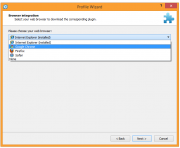
Browser integration
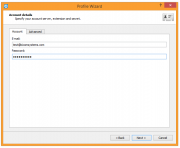
Account Details
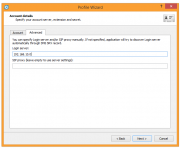
Advanced
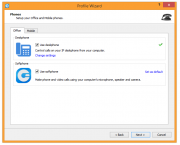
Phones
After the installation process, you need to configure VoIPOffice Communicator. Click on the VoIPOffice Communicator icon and the Profile wizard will appear. To continue with the configuration click the Next button.
1. Browser integration
- Select your preferred web browser to download the corresponding plugin. Once you finish with the configuration, the browser will open automatically, directing you to the plugin download page.
2. Account details
- Make sure you have received your account details from your system administrator or account manager. The received details must include:
- - E-mail, for example: example@telappliant.com
- - User password, for example: 93sU2e_2%
- - Server address, for example: voip.telappliant.com or 134.23.211.23
- - SIP proxy (leave empty to use server settings)
-
NOTE: In VoIPOffice Communicator 4.1, instead of an extension and secret, users will provide their e-mail assocciated with extension and User password.
After you click Next, VoIPOffice Communicator will try to connect to the specified server with the user's account details. If the account details are wrong, a red warning will appear. Otherwise, a Change Password pop-up window will appear telling you to change your password since this is the first time you are logging in. Your password has to be at least 8 characters and 85% secure. Users are required to change this password on login and once changed it is hashed and unknown for all administrators of the system.
3. VoIPOffice Communicator edition
- Select VoIPOffice Communicator edition. You may choose between Office, Business, Agent (Call Center), or Supervisor (Call Center).
4. Setup office and mobile phone
- Setup your Office phones. If you choose softphone, you will be able to place and receive calls using your computer. If you choose desk phone, you can control calls on your IP desk phone from your computer. Selecting the checkboxes for both desk phone and softphone will allow users to switch between devices when initiating a call and also to pick which device they would like to answer incoming calls on.
-
NOTE: If you use Polycom phones, click on 'My desk phone is Polycom'. Provide the phone's IP address and click Configure. This will help VoIPOffice Communicator to identify and configure Polycom phones.
- In VoIPOffice Communicator 4.1, users can assign Mobile Numbers that they would like to receive calls on when not at their desk. Click the Mobile tab and click + icon to add Mobile phone number and it’s label.
Click Next and a configuration summary window will appear. Please check the profile details and make sure they are correct. Click Finish and you will be automatically logged in with your account. Now you are ready to use VoIPOffice Communicator with all its features.
Working with VoIPOffice Communicator
Log In

Log In
- Provide the e-mail address that is assigned to your extension.
- Enter the password that you created during the VoIPOffice Communicator configuration.
- Enter the agent number.
- Enter the agent PIN number.
- Callback agent/Dynamic agent:
- Choose if you want to log in as callback or dynamic agent.
- Check if you want VoIPOffice Communicator to save your password.
- Log In automatically on startup
- When this option is turned on, VoIPOffice Communicator will log in automatically. Every time VoIPOffice Communicator is started, it will automatically log in.
- If a user forgets his password, he can recover it by clicking the ‘Forgot my Password’ link. The user will receive a password recovery link via email.

Communicator Toolbar
- A user-defined image that is displayed on the user's profile.
- You can change your avatar image by clicking on your current avatar and a new window will appear with avatar settings. Browse for the image from your computer and set the preferred image options.
- VoIPOffice Communicator now supports higher resolution avatars, allowing users to set up any resolution between 256x256 and 512x512 pixels
- User defined name which is shown in your chat conversations.
- Displays any missed calls or reads No Missed Calls.
-
Status and Status Message
- If left-clicked, a menu will open. The user will be able to choose his availability: Online, Busy, Do not Disturb, Away, and/or Offline. In My Settings -> Status, users can set their personal messages or news and upload their profile picture.
- Name, number and type of agent is displayed. For example, Agent: Agent Smith (Nr: 100, Callback)
- Put an agent on pause.

Communicator Toolbar
- Opens a softphone window next to the VoIPOffice Communicator main window.
- Opens a Voice conference window next to the VoIPOffice Communicator main window.
- Opens a Group Chat window next to the VoIPOffice Communicator main window.
- Opens a Voicemail window next to the VoIPOffice Communicator main window.
- In agent panel user can choose what he/she wants to display on panel, such as: all agents, all queues or alerts.
- Opens a 'Channels' window next to the VoIPOffice Communicator main window.
- Offers the choice to send a fax or view received faxes. Based on your choice, an additional window will open next to VoIPOffice Communicator.
- Opens the webcam preview window.
- Opens up a Surveillance Camera preview. This option will work only if you have your surveillance camera set up on the IP address in Tools --> Preferences --> Video --> Surveillance Camera.
- In order to login to Online Self Care, point your browser to: http://$IPADDRESS/ (For Example: http://192.168.1.1/)
-
-
Email: The email address assigned to the extension
- (ex. The provided email address is used as a username for logging into Online Self Care
- (e.g. email@example.com))
- ([a-z] [0-9] [@_.-])
-
-
Password/PIN: The PIN assigned to the extension
- (ex. This field accepts the extension's PIN (e.g.1981))
- ([0-9])
- Once a call is parked, it can be picked up by anyone at any location by dialing the parked extension.
- Opens a Search panel below the toolbar. Type the name of the contact that you wish to locate in the search panel.
- Opens a Preferences window. Refer to the Preferences chapter for detailed instructions.
- Redirects to our official website: www.telappliant.com. Additional documentation and guides are available on our official website www.telappliant.com If you still have any questions, please feel free to contact our support department.
Destinations and VoIPOffice Communicator Modules
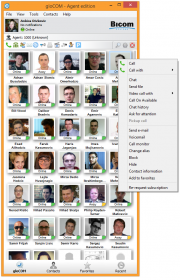
Right Click
VoIPOffice Communicator can place a call to any system destination, for example: extensions, queues, conferences, voicemail, system calls, or parking. Calls can be placed with a drag-and-drop motion from one extension to another, or directly from the phone display to the extension, for example. Right clicking on a contact name offers more possible actions regarding the selected extension.
This way the user can:
- - Make a call from VoIPOffice Communicator
- - Make a Video Call from VoIPOffice Communicator
- - Chat with the selected contact
- - Send an email to a contact
- - Block the selected contact
- - Call the selected contact On Available
- - Check Voicemail
- - Monitor calls
- - Add the selected contact to 'Favorites'
- - See more information about the contact
- - See a chat history with the selected contact
- - Re-request subscription
Placing Phone Calls
1. Open Phone module
- Click on the Phone module icon to show the Phone module.
2. Dial entering the phone number
- Use the Phone module dial keypad or keys on your keyboard to enter the phone number you want to dial.
- Click on the Dial icon to place a call.
3. Dial with Drag and Drop
- With your mouse click and hold any contact from the contact list, then drag the selected contact from the VoIPOffice Communicator list to the phone module area, and Release (Drop) the contact.
- Click the Dial button to place a call.
Live call
4. Transfer options:
- Blind/transfer to a phone number: Type in some number (i.e. mobile phone) and transfer the call to it.
- Transfer to another ongoing call: If a user has 2 or more active calls, he can transfer the calls from one to another. One simple scenario is: A VoIPOffice Communicator user is talking to John Doe. He receives a call from Allison Smith while speaking to John Doe. The VoIPOffice Communicator user is now able to add Allison Smith to the existing call with John Doe and all 3 participants will now hear each other.
5. Switch phone
- During a live call, you can use the Switch Phone button to initiate ringing across all registered devices so the user to continue the call on another device. A perfect example would be switching from your desk phone to your mobile when you need to leave your office but would like to continue your call.
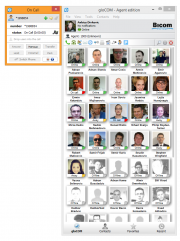
Call Monitoring
6. Call Monitor
If your administrator enables Call Monitor on your extension in VoIPOffice Enhanced Services, you will be able to listen to any call in real time. When a call is placed, right click on the user that is on call and choose Call Monitor. You can escalate from silent monitoring to “barging in” to speaking with all parties.
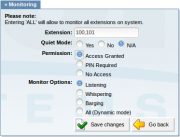
Call Monitoring
Phone
The phone module area where information about possible missed calls is shown.
- From the phone module you can set up office and mobile phones by clicking the settings icon next to missed calls information.
- Select your audio device by clicking the headset icon. It points to the Preferences->Phone->Audio devices section where you can choose which Input, Output, and Ringtone device to use.
- A green (or eventually red) circle shows the Phone module connection status. If green is shown, the Phone module is connected and the user can place calls. If a red circle is shown, the Phone module is not connected and the user is unable to place a call, in which case the user should contact their system administrator.
- The attachment sign is used to attach the phone module to the VoIPOffice window.
- In the Phone module you can see which phone mode is set by default. If you have selected both modes, click on the dropdown menu and switch to another mode. Next to this dropdown there is a DND icon with the option to set your status to Do Not Disturb.
- Phone module area where a contact is shown after the Drag-and-Drop action.
- Phone module area where a dialed contact's phone number is shown.
- Speaker volume tuner. Adjust the speaker volume by moving the slider up or down. Do not increase volume more than needed because it can induce hearing loss.
- Microphone volume tuner. Adjust the microphone volume by moving the slider up or down.
- Phone module dial keypad. Used for entering phone numbers.
 - When a phone number is entered, click on the Call button to place a call.
- When a phone number is entered, click on the Call button to place a call.
 - When a phone number is entered, click on the Video button to start a Video call.
- When a phone number is entered, click on the Video button to start a Video call.
 - When a new Voicemail message is available, this button will flash.
- When a new Voicemail message is available, this button will flash.
- Click on the Voicemail button to check your voicemail.
 - Click on the Redial button to redial the last dialed contact or phone number.
- Click on the Redial button to redial the last dialed contact or phone number.
Voice Conference
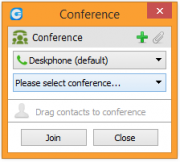
Voice Conference
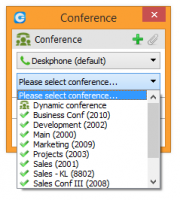
Voice Conference

Conference Call
- Group Chat module area where the name of the module is shown.
- Plus sign used to invite a contact using his landline or mobile number.
- The attachment sign is used to attach the phone module to the VoIPOffice window.
- Select a box to choose from a conference room


Drag Contact
- The Voice Conference module area where a contact is shown after Drag-and-Drop.
- To remove a contact from a Chat Group, click

- Click on
 button to start the Voice Conference.
button to start the Voice Conference.
- Click on
 to close the Voice Conference.
to close the Voice Conference.
Chat in a Group
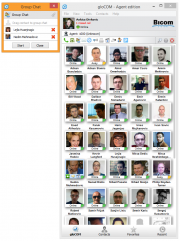
Group Chat
1. Open Group Chat module
- Click on Group Chat module icon to show Group Chat module.
2. Group Chat with Drag and Drop
- With your mouse click and hold any contact from the contact list, then drag the selected contact from the VoIPOffice Communicator list to the Group Chat module area, and Release (Drop) the contact. Repeat this action to Drag-and-Drop more contacts into the Group Chat.
- Click on the Start button to start a Group Chat with the selected contacts.

Group Chat
- Group Chat module area where the name of the module is shown.
- Attachment sign is used to attach phone module to VoIPOffice window.

Drag and Drop
- Group Chat module area where contact is shown after Drag and Drop action.
- To remove a contact from the Chat Group, click on

- Click
 to start the Group Chat.
to start the Group Chat.
- Click
 to close the Chat Group window and stop the Group Chat.
to close the Chat Group window and stop the Group Chat.
Voicemail
- Select a Voicemail message and click to delete it. Please note, voicemail delete is permanent.
- Click to move the selected voicemail message to the old messages directory.
- Click
 to place a call to a contact who left a voicemail message.
to place a call to a contact who left a voicemail message.

Voicemail
- Click
 to play the selected voicemail message.
to play the selected voicemail message.
- Click
 tab to show new voicemail messages.
tab to show new voicemail messages.
- Click tab to show old voicemail messages.
Agent panel
Agents
- Search can be based on agent's number or name.
Settings
1. Agents:
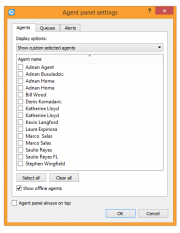
Agent Panel Settings
- From drop down list, user can select the following options:
- Show only agents from my queues
- Show all agents
- Show custom selected agents
- Click on check box for this option in case you want to see offline agents.
- Agent panel always on top:
- Click on check box for this option in case you want to set the agent panel always on top.
2. Queues
- The following display options are offered:
- Show my queues only
- Show all queues
- Show custom selected queues
- Agent panel always on top:
- You will use this option in case you want to set agent panel always on top.
3. Alerts
- Threshold (minutes): Select or enter the number which will represent Threshold in minutes.
- Refresh time (seconds):
- Select or enter the number which will represent Refresh interval in seconds.
- Alert interval (minutes):
- Select or enter the number which will represent interval in minutes after which alert will repeat.
- Show popup for alerts
- Click on check box if you want to show popup for alerts.
- Alert me for my queues only
- Click on check box if you want to receive alerts only for agent's queues.
- Agent panel always on top
- Click on check box for this option in case you want to set agent panel always on top.
Queues
- Search queue based on queue number or queue name.
- Clicking on "Alert" option, list of alerts is displayed. Here you can delete alerts, or change already configured options for alerts in Settings section.
- This option is same as Agent Settings.
Hide Agents/Queues
- This option is used if you want to see only one of the Agent or Queue section. For example, in case you want to display only Agents, you will click on "Hide Queues" option.
Channels
- Channels module area where the name of module is shown.
- The attachment sign is used to attach the phone module to the VoIPOffice window.
- Click to choose a department to which the user wants to send a message.
- Click to open a Channels message window.
- Click
 to close the Channels module window and stop the Channels conversation.
to close the Channels module window and stop the Channels conversation.
|
Placing Video Calls
To place a video call, right click on a VoIPOffice Communicator contact and select Video Call from the drop-down menu.
|
Sending Fax
|
1. Outgoing faxes
- Click on the Fax module icon, then select Send fax to open the Fax module.
- Read the information message and click the OK button.
PDF file:
- Enter the path or browse for a PDF file that you wish to send using the icon.
Information that you enter in the Send FAX wizard will be displayed on the FAX cover page if you choose to send a cover page. In the Send Fax window you can see two sections, To and From.
To Section
- Enter the name of recipient. For example, Tim Barr.
- Enter the phone number to which you want to send your fax, for example 02033998800.
- Enter the phone number of the recipient.
- Enter the recipient's email.
- Enter the recipient's company name.
From Section
- This field will be automatically populated with your VoIPOffice Communicator username.
- Enter your fax number.
- Enter your phone number.
- Enter your email.
- Enter your company's name.
Additional information like comments and status can be entered also.
|
2. Incoming faxes
- Show list of all received and pending fax documents.
- Click to Refresh the list of incoming faxes.
- Click to Download the selected fax files to your hard drive.
To set up your Fax Printer, consult our Faxing guide for WINDOWS or MAC OS X
|
Video Window
Opens the webcam preview window.
Camera
Opens up a Surveillance Camera preview. This option will work only if you have your surveillance camera set up in the IP address in VoIPOffice Communicator --> Preferences --> Video --> Surveillance Camera.
Online self care
- In order to login to Online Self Care, point your browser to: http://$IPADDRESS/ (For Example: http://192.168.1.1/). When you click on the VoIPOffice Communicator OSC icon, you are automatically directed to your OSC page.
-
Email: The email address assigned to the extension
- (ex. The provided email address is used as a username for logging into Online Self Care
- (e.g. email@example.com))
- ([a-z] [0-9] [@_.-])
-
Password/PIN: The user password assigned to the extension
- (ex. This field accepts your VoIPOffice Communicator password (e.g.n9h*Caq1Icr))
- ([0-9])
Quick List
Quick list buttons enable a quick overview of VoIPOffice Communicator, Contacts, Favorites, and Recent tabs.
-
VoIPOffice Communicator. Switch to VoIPOffice Communicator. Displays a list of all VoIPOffice Communicator contacts.
-
Contacts. Switch to Contacts view. Displays a list of all saved and imported contacts.
-
Favorites. Switch to Favorites view. Displays all contacts that you marked as a favorite.
-
Recent. Switch to Recent view. Displays log of all recent missed, received, and dialed.
- Log Out
- Click on Log Out to log out from active connection(s).
- Exit
- Click on Exit button to log out from active connection(s) and close VoIPOffice Communicator application.
|
View
1. Chat History
- Shows a history of chat conversation with your contacts.
-
Users (field)
- List of all contacts the user chatted with.
- Displays chat history per date.
- Click on the Delete button to delete the selected chat conversation.
- Click on the Delete All button to delete all chat conversations with selected contact.
- Users can use the Chat History Search feature to search for a term in the search history.
- Enter a term to be searched.
- Select one particular or all users from the list.
- Choose any or a specific date for your search.
|
2. Departments
- Show a list of company departments at the bottom of the VoIPOffice Communicator window.
|
3. Received faxes
- Inbound Fax Documents
|
4. Contacts
- You can choose the VoIPOffice Communicator users list layout. Choose between Large Icons, Small Icons, and Grid View.
|
5. Diagnostic logs
- Here you can see diagnostic logs with the level of verbosity that you have set in Preferences->General->Diagnostic Logs.
- Add Fax Printer Automatically
- Add Fax Printer Manually
- Install Port Monitor
- Click on Download web browser add-ons to add the browser add-on which will allow the user to select and dial a phone number directly from a web page. Supported browsers: Internet Explorer, FireFox, Safari, and Chrome.
- VoIPOffice Communicator edition...
- Change the VoIPOffice Communicator edition.
- Changing VoIPOffice Communicator editions is not possible in case if "Shared configuration" is enabled.
- Enable:
- By enabling shared configuration, all users on this computer will share same Login account, phone mode and edition.
- Account:
- E-mail: email address is displayed in this field.
- Password: in case that option "Enable" is unchecked, password will be hidden. After you check "Enable" option, option "Show Password" will be functional.
- Login Server: Shows IP address of server.
- SIP proxy (optional): this field is optional.
- Edition: In this option select edition for your VoIPOffice Communicator. Current edition is displayed, but possibility to choose between other editions is given.
- Phones
- Choose which phones you want to use:
- Softphone: choose to use Softphone.
- Deskphone: choose to use Deskphone.
- Polycom: choose to use Polycom phone.
- Polycom IP:
- In case that user chose Polycom, in this option user needs to provide IP address of Polycom phone.
- Click on Preferences to open VoIPOffice Communicator settings. For more about preferences, please visit the Preferences chapter.
- Click to sort contacts according to status.
- Sort contacts alphabetically
- Click to sort all contacts in alphabetical order.
- Click to display only users that are online at the time.
- Click on the Privacy List to view blocked and hidden users.
- -Blocked users
- When you block a user, he or she cannot see you 'Online' and cannot send messages to you.
- -Hidden users
- When you hide a user, he will not be in your list of your contacts, but you will be able to search for him.
Help
1. VoIPOffice Communicator Help
Communicator is Up-to-date
- Redirect to our official website www.telappliant.com
- Additional documentation and guides are available on our official website: www.telappliant.com. If you still have any questions, please feel free to contact our support department.
2. Check for updates
- Check online for official product updates.
- If there are updates available, the software will apply them automatically. If your software is up to date, you will receive a message as stated above.
About VoIPOffice Communicator
3. About
- Information about the current version of VoIPOffice Communicator.
Added automatic crash report system.
If Communicator crashes, the user has the option to send a crash report for developers to analyse the issue and solve the problem.
Preferences
General
General settings
1. Launch application at startup
If checked, this allows VoIPOffice Communicator to start up automatically when the OS starts.
2. Log In automatically on startup If checked, this allows user to login in VoIPOffice Communicator, when user starts VoIPOffice Communicator.
3. Set default associations button (tel://, sip://, callto://, etc)
- Clicking on this button, new window pops up.
- User can select the extensions that he wants this program to open by default.
4. Language
- Select your language.
- Click on the Add language button to add another language.
-
NOTE: Application restart is required
5. Always on Top
Select one of the following options:
- - Disable always on top - All other windows are behind the VoIPOffice Communicator window
- - Call window always on top - All other windows are behind the call window
- - Call and Contacts window always on top - All other windows are behind the VoIPOffice Communicator and call windows
6. Updates
Allows VoIPOffice Communicator to check for latest updates automatically. Please note, the user will be asked if he wants to download the latest software updates and update VoIPOffice Communicator. You can set updates to be checked Daily, Weekly, or Monthly.
7. Diagnostic logs
If this option is enabled, then all SIP and PWProxy information will be logged.
- Here you can set a level of verbosity for SIP logging. You can choose between 1 - 10 levels.
You can choose between four logging levels for Jabber: Error, Warning, Info; Debug.
8. Tray icon blink duration (for pending notifications)
User can set how long icon notifications will blink for pending, not reviewed VoIPOffice Communicator notifications.
When you make a change, click OK. If you do not want to make any changes, click Cancel.
1. General
Display size
- Display size of users and contacts (list view)
- This option applies for the list view only.
Grid view options
- When this option is checked, VoIPOffice Communicator will show users in a grid view (thumbnails).
- Show the names of contacts.
- Show status of contacts.
Online Users
Allows the user to define conditions that need to be met for a user to be considered an 'online' user. In the main window, the user has the option to show only "Online" users.
- - Online on IM and Phone - when this option is selected, a user will be considered "Online" if he is available for both Chat and Phone calls.
- - Online on IM or Phone - when this option is selected, a user will be considered "Online" if he is available for either Chat or Phone calls.
- - Online on IM - shows only contacts who are logged in VoIPOffice Communicator.
- When this option is selected, a user will be considered "Online" if he is available for Chat.
- - Online on Phone - shows only contacts who are connected with their phone.
- When this option is selected, a user will be considered "Online" only if he is available for Phone calls.
Default contact double-click action:
- When you choose the chat option, double clicking a contact will open a chat window.
- If you choose the call option, double clicking a contact will call the contact.
2. Google
- Enable Google contacts integration
- Check this box if you want to integrate your Google account contacts with VoIPOffice Communicator
- Enter the Google e-mail and password with which you want to integrate.
- Here you can specify your proxy server and port.
3. Outlook
- In order to enable Outlook contacts integration with VoIPOffice Communicator you need to enable VoIPOffice Communicator plugin in Outlook and check the Enable adding of Outlook Contacts box.
Phone
General
1. Hide the keypad after a call is placed
2. Dynamic conferencing (softphone)
- Use system Conferencing (recommended) - the server is used for mixing audio (DYNAMIC conference on Asterisk)
- Use 3-way conference call (SIP) - SIP client to make 2 calls on local computers is done by mixing
3. Ring volume
- Logout for changes to take effect.
4. Office and Mobile phones
- Set up your Office and Mobile phones here. Unified Communications allows you to use multiple phones simultaneously including a softphone, desk phone, and mobile phone.
My phones...(button)
When you click on the My Phones button, a new window will open with two tabs, Office and Mobile.
Office
- If you check "Use softphone", you can place and receive phone calls using your computer.
- If you check "Use desk phone", you can control calls on your IP desk phone from your computer.
NOTE: If your desk phone is Polycom, check "My desk phone is Polycom" and enter the IP address of the phone in the "Polycom IP address" field. Click Configure so you can configure Polycom for use with VoIPOffice Communicator.
Mobile
- Click on the Mobile tab and click the + icon to add a Mobile phone number and its label.
NOTE: Adding mobile numbers between VoIPOffice Communicator and VoIPOffice is integrated, so you only have to do it either on your VoIPOffice Communicator or in your extensions Enhanced Services.
|
Audio devices
1. Input device
2. Output device
- Headphones or other sound device that you can playing sound.
3. Ringtone device
- Separate the audio device, but it can be the same as the output so that you do not have to keep your headphones on all the time to hear the phone when it rings.
Dialing Rules
1. Dialing rules
- Here you can set dialing rules for outbound calls.
- For example, if a user copies and pastes a phone number (from the clip board) and it starts with a + sign, it will be replaced with the international dialing code 00 by applying the following rule.
- Multiple rules can be defined.
- The Add and Remove buttons are used to add another dialing rule or to remove the selected rule from the list.
Regular expressions can be used for the text that will be replaced.
|
Speed dial
Added speed dial.
The user can configure speed dial in VoIPOffice Communicator. The allowed digits are in the 1-99 range. This is not to be confused with the VoIPOffice speed dial. This is a local option saved on the computer where VoIPOffice Communicator is running.
|
|
Codecs
List of all available codecs are sorted by priority.
|
Advanced
1. Encryption
- We recommend using settings from the server, but you can also use encryption for voice and video calls (TLS and SRTP)
2. Register every
- The number of seconds after which VoIPOffice Communicator will re-register the SIP softphone.
3. Local SIP port
- Which port to bind on locally (on the PC). Leave empty to use any available port.
5. Send keep alives
- Enable this option for VoIPOffice Communicator to send SIP Keep-Alives to the server. Contact your system administrator for more information.,
|
Video
In order to use Video Calls, your VoIPOffice Communicator has to be set up as a soft phone.
Make sure your UAD in Profile -> General is set to VoIPOffice Communicator
|
|
Quality
- Here you can change the quality of your video. For example: If your bandwidth is low or you are experiencing temporary networking issues, you can set the video quality to Low resolution to get better video performance.
|
|
Codecs
List of codecs sorted by priority. You can change the codec settings in the "Advanced codec settings" section, but we recommend using default values.
|
Devices
- By default, VoIPOffice Communicator uses your system camera. If you have another camera attached to your PC, it will be listed in the dropdown menu.
NOTE: Colorbar generator is used for testing video.
|
|
Surveillance Camera
- Surveillance Camera settings
- VoIPOffice Communicator enables you to watch your IP surveillance camera stream at all times by simply entering its URL. Now you can turn surveillance on or off with a single click of the mouse or position it to be always on top by checking the box Always on top.
|
CRM
Customer Relationship Management (CRM) is a widely implemented model for managing a company’s interactions with customers, clients, and sales prospects. It involves using technology to organize, automate, and synchronize business processes: sales activities, marketing, customer service, and technical support. VoIPOffice Communicator offers implementation with your CRM system and it will make it even more efficient.
VoIPOffice Communicator 4.x is compatible with several Customer Relationship Management solutions. We now support Salesforce, SugarCRM, Zoho, and Zendesk.
For example, if you have a CRM with all of your customers' information in it (names, phone numbers, addresses etc.) set up for working with VoIPOffice Communicator:
When an inbound call comes into VoIPOffice Communicator it will pass the Caller ID to your CRM, the system will match it with your customer's entry, and your default web browser will be launched with information about that customer.
1. CRM
- Popup on inbound calls when:
- Choose when you want to launch the CRM customer page.
- Options:
- -When I answer the call
- -When I receive a call
- -Never
- Popup on outband calls when:
- Choose if you want to launch the CRM customer page on outband calls.
- Options:
- -Never
- -When the call is started
- -When the call is answered
Authentication
- Here you will provide the username of your CRM account.
- Enter the password of your CRM account.
- The default URL that VoIPOffice Communicator uses to connect and work with the CRM Integration Service. For local services, this URL is configured on the server, but each VoIPOffice Communicator instance can set its own address if needed.
Logging options
Here you can choose whether you want to use logging options from the server or you want to configure which details to log. Logging options are useful if you notice some unexpected behavior so you can check log files for more information. Options:
- Use settings from the server
- Log inbound calls
- Log outbound calls
- Log answered calls
- Log unanswered calls
- Upload recordings
When integrated with any of the aforementioned CRMs, VoIPOffice Communicator will synchronize CRM contacts and display them in the CRM contacts tab.
Custom information is represented by macros in the URL. Once the URL is used during a call, the macros will be replaced with corresponding information from the call. For every URL request, except in silent mode, a website matching the URL will be shown in the browser.
NOTE: Popups do not work for local calls. In the URL field, the following macros can be used:
- %callerid% - Remote phone number
- %callerid_name% - Remote party name
- %ext% - Local extension
- %duration% - Duration of the call
- %callid% - Call ID
- %direction% - Inbound or Outband
In the silent mode, the URL request will silently be sent to the server.
|
Alerts
General
- Bring application to front when I receive a call.
Click on check box for bringing the application to front when you receive a call.
- Inbound Call Popup duration
Select time in seconds for call popup duration.
Notifications
By checking the checkboxes, you can turn VoIPOffice Communicator notifications on or off:
- Notify me when I receive a phone call
- Notify me when a contact comes online.
- Notify me when I receive a message.
- Notify me when somebody joins a conference
Sounds
Here you can change the default notification sounds. Double click an item to change the sound file. You can choose whether you want to play a notification sound for new messages by checking/unchecking "Always play a notification sound for new messages on chat". You can set sounds for when:
- - A contact Signs In
- - A new Instant Message Received
Inbound Call Pop-up duration
- Here you can set the number of seconds that a call pop-up will be visible.
Bring the application to the front when I receive or place a call
- If this option is checked, VoIPOffice Communicator will be brought to the foreground when a user receives (or places) a call.
Chat
1. Automatically set status to Away when I am idle for:
- Use this option to decide after how much idle time VoIPOffice Communicator should show you as Away.
- This option is related to user's activity (computer usage), so if no action is done on your computer after the set number of minutes, VoIPOffice Communicator will change your status to Away.
2. Show status change messages in Chat window
- If checked, while in a chat conversation with another contact, if the user goes away or becomes busy, a message will be displayed in that chat window and the contact will be able to see the message. For example, John Doe went away.
3. Send my "seen" status in Chat window. If disabled, you will not be able to see others "seen" status.
- If checked, user can see if his message was read.
4. Save received files to: Here you can specify the location where VoIPOffice Communicator will save received files:
5. Navigate chat conversations with: Here you can set the layout of the chat window. Whether you want your chat conversations to be in the Side Panel or in Tabs.
6. Save Chat history on this computer
Profiles
1. Profiles
- Use the Add button to create a new profile. Use Edit and/or Remove on existing profiles on the list.
2. Add a new profile
- Click on the Add button and a popup window will appear.
- Fill in all fields to properly configure VoIPOffice Communicator.
- Profile name
- Enter any desired name (A-Z, 0-9), for example: John Doe.
- The server host name or IP address of VoIPOffice, for example: voip.telappliant.com or 134.23.211.23
- Your phone's local extension, for example: 1029.
- Your password is the secret code that you need for authorization with VoIPOffice, for example: 93sU2e_2%
- Choose VoIPOffice Communicator as a User Agent Device that you use.
- Click the OK button to save the configuration and finish, or the Cancel button to exit the configuration without saving.
-
NOTE: Multiple profiles are not available in Shared configuration mode.
Advanced
Polycom
- Polycom listening port: Specifies the local port on which VoIPOffice Communicator will listen for Polycom events.
|
|
|
|
|
|
|
![]() - When a phone number is entered, click on the Call button to place a call.
- When a phone number is entered, click on the Call button to place a call.![]() - When a phone number is entered, click on the Video button to start a Video call.
- When a phone number is entered, click on the Video button to start a Video call.![]() - When a new Voicemail message is available, this button will flash.
- When a new Voicemail message is available, this button will flash.![]() - Click on the Redial button to redial the last dialed contact or phone number.
- Click on the Redial button to redial the last dialed contact or phone number.

 button to start the Voice Conference.
button to start the Voice Conference. to close the Voice Conference.
to close the Voice Conference.
 to start the Group Chat.
to start the Group Chat. to close the Chat Group window and stop the Group Chat.
to close the Chat Group window and stop the Group Chat. to close the Channels module window and stop the Channels conversation.
to close the Channels module window and stop the Channels conversation.

























